![]()
![]()
EARLY ORIGINS: GROWTH AND EXPANSION
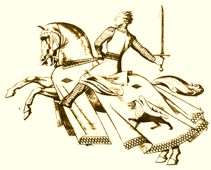
Written by Gevork Nazaryan
The history of this great city began in a more distant place, quite afar from the location on the left bank of the Arax river in a close proximity to the city of Kars. The name Ani comes from the ancient Armenian city of Ani, located in the Bardzr Haik or Upper Armenia province of Greater Armenia. The city of Ani located in Upper Armenia was a sacred place of worship of the pagan gods of Armenia. On the current location of Ani on the Left Bank of the River Akhurian, archaeologists have found remains of an early bronze culture and as well as burial shrines within man-made hilltops or blurs dating back to the VIIIth and VIIth centuries B.C. Ani is first mentioned by Armenian historians Ełishēi and Łazar P'arpets'i in the Vth century A.D. as a strong and impregnable castle built on a hilltop in possession of the Kamsarakan nobility. The castle was built at a strategically fortified point near a chain of mountain cliffs which formed a natural obstacle and a barrier against possible sieges. From the north, the castle was fortified by a thick, long wall. The shift in the possession of the city took place in the IXth century A.D. when Ashot Bagratuni, the supreme lord of Armenia, bought the castle along with the nearby estates of Arsharunik' and Shirak, from the House of Kamsarakan.
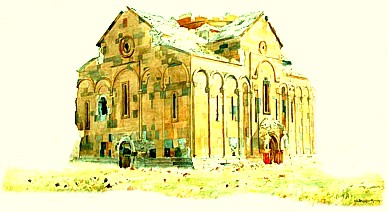
THE REMNANTS OF THE MOTHER CATHEDRAL
1905 PAINTING BY ARSHAK FETVAJYAN [1866 - 1947]
Under the rule of the increasingly growing power of the Bagratids, who by the late IXth century had liberated Armenia from Caliphate's rule and restored the Armenian Monarchy, Ani became an expanding and growing city. In 961 A.D. the Bagratids proclaimed Ani as the new capital of Armenia, replacing the earlier Kars as the Mother City. In 964 A.D. King Ashot III erected new, bigger and better walls that surrounded the capital, thus giving Ani a more formidable status. By the end of the Xth century, due to

the strategically important location of the city and the protection and opportunities offered, a large flow of peasant population made up the growing number of the citizenry. This in its turn gave Ani the necessary man power to become a truly international center of trade and commerce.
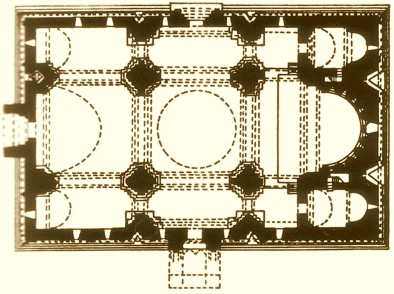
FLOOR PLAN OF THE MOTHER CATHEDRAL
The city's famous craftsmen and artisans through their works made Ani a world famous cultural and commercial hub of the period. Merchants and craftsmen flocked to Ani from old cities such as Dvin and Kars, which during this period had to secede their supremacy to Ani. In 989 A.D. to assure and to show the grandeur of Ani King Smbat of the Bagratid Royal House built the second layer of walls around the city making the city virtually invulnerable to an enemy conquest from outside. Many of the noble houses and knights loyal to Bagratid kings built their mansions and palaces such as the Palace of Baron, the great city walls of Smbatashen and Ashotashen which had built-in chapel towers which held mass and gathered the faithful of the city.
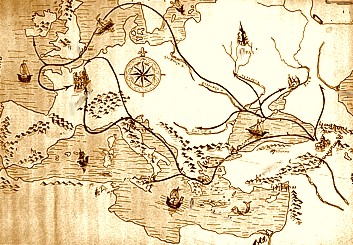
THE DIFFUSION OF ARMENIAN ARCHITECTURAL INNOVATIONS
FROM ARMENIA TO EUROPE AND BEYOND
New marketplaces, taverns and workshops were built to house and control the flow of traffic of the city. New churches and monasteries were also built by the finest craftsmen and architects of Armenia, (master Trdat being the most notable) who gained fame by the building of the churches such as the splendid and grandeur Church of Gregory the Illuminator built by Tigran Honents, The Church of the Savior and the Beautiful Mother Church of Ani or St. Mary's Church which many travelers called the Jewel of Caucasus.
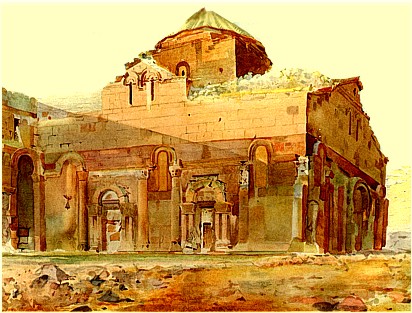
R U I N S O F T H E
T E K O R B A S I L
I C A [F I F T H C E N T U R Y]

T H E F L O O R
P L A N O F T
E K O R B A S I L I C A
The construction of the church began during the reign of Smbat II in the year 898 A.D., after thorough planning by the court architect Trdat and was completed during the reign of Gagik I in the year 1001 A.D. The church was covered with beautiful frescos and traditional Armenian ornamental decoration, biblical scenes and the history of the House of Bagrat. The Church was amongst the most notable and large architectural structures in Ani and even the remaining ruins today have a certain allure and majesty.
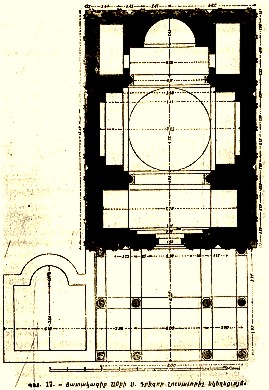
THE FLOOR PLAN OF ST. GREGORY'S CATHEDRAL
The city had numerous churches and chapels [hence the symbolic name -- City of 1001 churches] in order to fulfill the spiritual life of tens of thousands of Armenian Christians, who lived in the city. Churches such as the Church of the Apostles, the Church of the Holy Pastor Jesus Christ were also among the most notable, in dimension and function. Many of the architectural marvels of Ani were lost and buried under deep layers of dirt. In late XIXth century and early XXth century a renewed interest in archaeology and architecture, and in particular the culture, the history and the architecture of Ani resulted in a number of expeditions by most notably scholars from the Russian Empire.
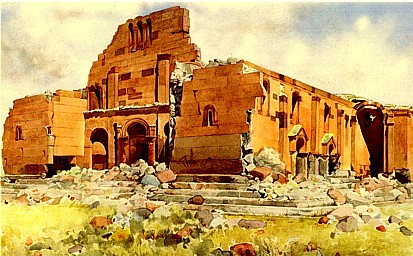
R U I N S O F T H E E
R E R U Y K B A S I L I C A
[F I F T H C E N T U R Y]
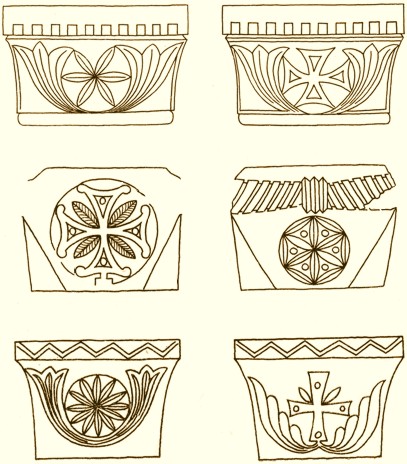
E R E R U Y K COLUMN PILLARS DECORATED WITH
SOLAR + LUNAR MARKINGS --
THE CRESCENT-LIKE FERTILITY BRANCHES OF GLORY BELOW STAR-CROSSES.

C A P I T O L
F R O M H A G H P
A T

F L O O R P L
A N O F T H E
E R E R U Y K B A
S I L I C I A
This was directly as a result of the Russo-Turkish War of 1877-78, in which the Ottoman Empire suffered yet another defeat and was forced to withdraw and the province of Kars became part of the Russian Empire. From this period until first two decades of the XXth century when Kars was part of the Russian Empire and later the First Republic of Armenia, a number of archaeological expeditions took place (most of the archaeological digs in the backward Ottoman Empire were done by Armenian and European archaeologists, this is to a great extent the case to this day).
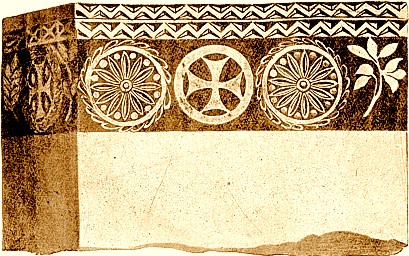
A SECTION OF THE CAPITOL OF THE ERERUYK BASILICA
Excavations and mappings took place after several expeditions by the famous architectural historian, T'oros T'oramanyan, and as well as distinguished armenologist, historian, archaeologist and linguist Nikolai Marr, who first began excavations in 1892, organized the second expedition in 1904.
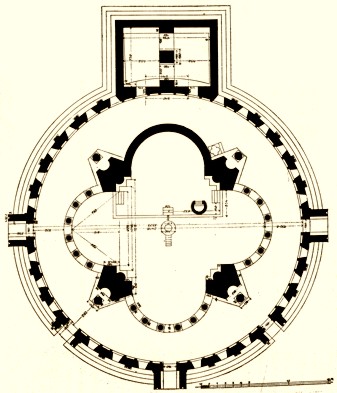
THE FLOOR PLAN OF THE ZVARTNOTS/GAGKASHEN CATHEDRALS

THE HUGE GAGKASHEN CATHEDRAL OF ANI [XTH CENTURY] WAS ERECTED
ACCORDING TO THE GENERAL LAYOUT OF THE VIITH CENTURY ZVARTNOTS CATHEDRAL

THE FLOOR PLAN OF THE BANAK CATHEDRAL.
HARMONY AND ORDER. TERRESTRIAL MIRROR OF THE
CELESTIAL SOLAR PRECESSION THROUGH THE HOUSES/AGES.
T'oramanyan's publications of the excavations, including detailed sketches of the ruins and extracted artifacts were meticulously studied by the famous professor of Vienna University, Joseph Strizhigovski, who greatly contributed in restoring and reviving the lost treasure monuments and architectural marvels of Ani with his detailed sketches of the buildings the way they looked in the days of glory. Ani had commercial ties with the cities of the Byzantine Empire, Persia, Southern Russia and Central Asia. Fine china was imported from China, silk, expensive and exotic crystals were brought in from distant lands.
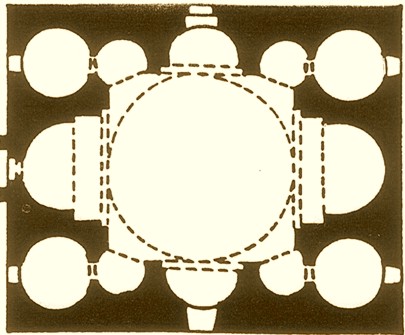
F L O O R P L A N
O F A V A N
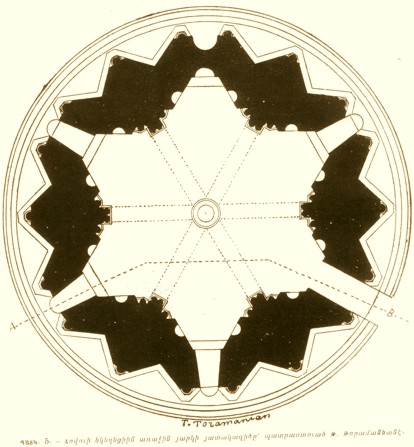
FLOOR PLAN OF THE CHURCH OF THE SHEPHERD [ORION]. FUSION.
STUDY BY THE OUTSTANDING ARCHITECTURAL HISTORIAN
T‛OROS T‛ORAMANIAN.

DIVINE HARMONY OF THE CHURCH OF THE SHEPHERD

Ē -- THE
SEVENTH SACRED LETTER FORMS THE STEM/POLE
OF TWELVE POINTS AROUND FIXED CENTER...
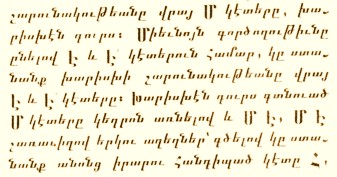
DIAGRAM BELOW
Ani had strong commercial ties with the cities of Cilician Armenia, which during this period had a considerable Armenian population. Armenian fine rugs made of soft wool were famous throughout the ancient world for their beauty and quality. Armenian master jewelers made beautiful and delicate necklaces, rings and earrings of precious stone and rubies of the finest quality and elegance.

HARMONY AND ORDER OF
THE CHURCH OF THE SHEPHERD
FURTHER READING | HIGHLY RECOMMENDED:
VIRTUAL ANI -- A
TRULY GREAT SITE
SPECIFICALLY DEDICATED TO THE CITY OF ANI
http://www.virtualani.freeserve.co.uk/